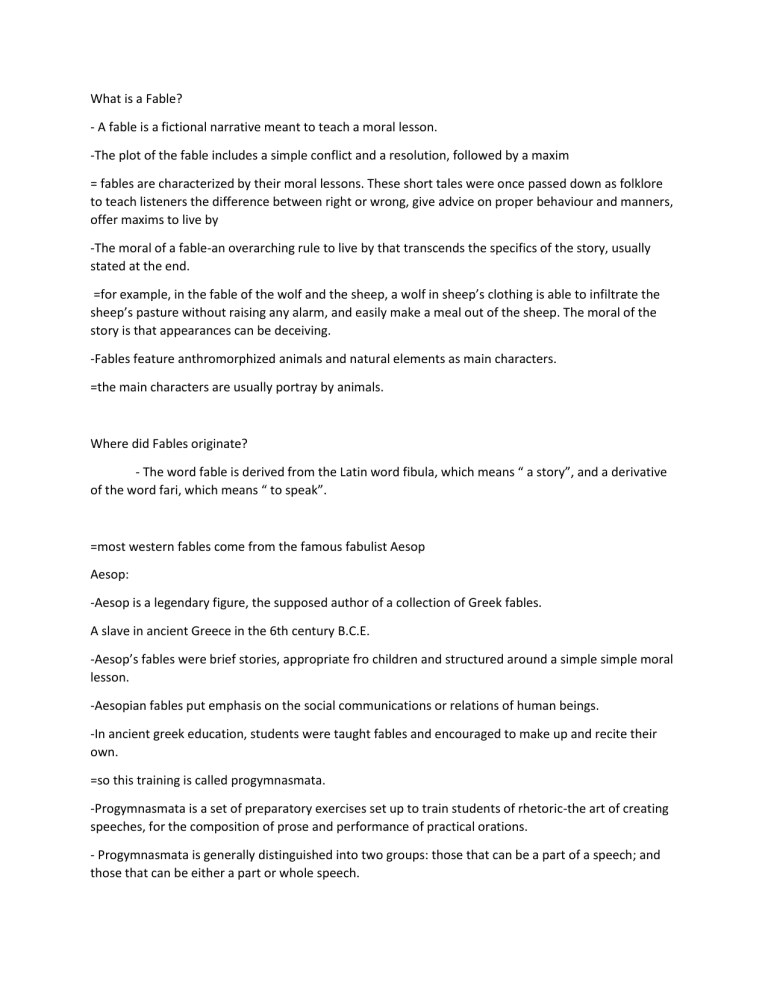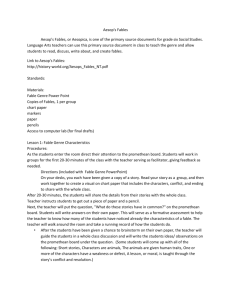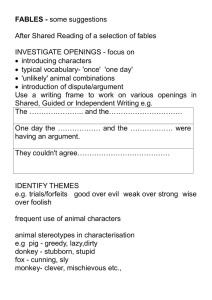
What is a Fable? - A fable is a fictional narrative meant to teach a moral lesson. -The plot of the fable includes a simple conflict and a resolution, followed by a maxim = fables are characterized by their moral lessons. These short tales were once passed down as folklore to teach listeners the difference between right or wrong, give advice on proper behaviour and manners, offer maxims to live by -The moral of a fable-an overarching rule to live by that transcends the specifics of the story, usually stated at the end. =for example, in the fable of the wolf and the sheep, a wolf in sheep’s clothing is able to infiltrate the sheep’s pasture without raising any alarm, and easily make a meal out of the sheep. The moral of the story is that appearances can be deceiving. -Fables feature anthromorphized animals and natural elements as main characters. =the main characters are usually portray by animals. Where did Fables originate? - The word fable is derived from the Latin word fibula, which means “ a story”, and a derivative of the word fari, which means “ to speak”. =most western fables come from the famous fabulist Aesop Aesop: -Aesop is a legendary figure, the supposed author of a collection of Greek fables. A slave in ancient Greece in the 6th century B.C.E. -Aesop’s fables were brief stories, appropriate fro children and structured around a simple simple moral lesson. -Aesopian fables put emphasis on the social communications or relations of human beings. -In ancient greek education, students were taught fables and encouraged to make up and recite their own. =so this training is called progymnasmata. -Progymnasmata is a set of preparatory exercises set up to train students of rhetoric-the art of creating speeches, for the composition of prose and performance of practical orations. - Progymnasmata is generally distinguished into two groups: those that can be a part of a speech; and those that can be either a part or whole speech. -the first exercise in the progymnasmatic series required students to retell one of Aesop’s fables. The students ability to narrate would be stretched by the further requirement that they tell the same story backwards or starting in the middle. -Fables have a long European history. In the 17th century, French fabulist Jean de la Fontaine was inspired by Aesop to write fables that satirized the church, the court, and the rulling class of the time. -De la Fontaine considered the moral to be the core element of the fable -many European writers were inspired by de la Fontaine, including the Russian fabulist Ian Krylov Panchatantra - is a compilation of inter-woven series of tales in prose and poetry, mostly animal fables. -was composed in Sanskrit language around 3rd century BCE and was attibuted to Pandit Vishnu Sharma -aims to illustrate the primary Hindu principles if nїti-the wise conduct of life - Traditionally, fables are written to teach children their culture’s appropriate behavior and values, but there are some exceptions. For example, George Orwell’s allegorical novel Animal Farm has some characteristics of a fable, even though it was a satire written for adults. Four Central Characteristics of a Fable 1. Symbolism. Characters in fables are stand-ins for human, and their misadventures are meant to symbolize human behavior. 2. Anthropomorphization. In fables, animals and even inanimate objects (like the wind, or the sun) are the main characters of the story and are given human qualities. Some animals have specific traits associated with them. For example, an owl is wise, a fox is cunning, and a lion is brave. 3. Lessons. Every fable has a moral lesson at the end that arises from story. For example, “slow and steady wins the the race.” 4. Humor. Fables often have a humorous tone when showing the foolishness of human nature. Four Examples of Famous Fables Some of the most famous fables include: • The fox and the grapes. This fable is the origin of the phrase “sour grapes.” A fox spies a bunch of grapes high up on a branch and wants them badly. He takes a running jump to reach them but misses. He tries several more times, but to no avail. Finally, he gives up and walks away scornfully. The moral of the tale is: “There are many who pretend to despise and belittle that which is beyond their reach.” • The lion and the mouse. A lion catches a mouse, who begs to be let go. The mouse promises to repay the lion in exchange for his life. The lion agrees and lets the mouse go. A few days later, the mouse comes upon the lion trapped in a hunter’s net, and, remembering the lion’s mercy, gnaws on the rope until the lion is free. The moral of the story is: “A kindness is never wasted.” • The tortoise and the hare. The tortoise and the hare enter a footrace. The hare jeers at the tortoise, remarking how naturally he is so much faster than the slow tortoise. During the race, the hare takes several long breaks and wastes time relaxing between quick sprints. Meanwhile, the tortoise chugs steadily along. In the end, the tortoise wins. The moral of the story is: “Slow and steady wins the race.” • The fox and the crow. A hungry fox comes upon a crow up in a tree with a bit of cheese in its mouth. The fox begins to talk to the crow, telling her she is so beautiful and must have a beautiful voice to match. At first, the crow stays silent, holding on to her cheese. But at last, after much flattery, she opens her mouth to crow. The cheese falls into the fox’s mouth. The moral of the story is: “The flatterer lives at the expense of those who will listen to him.” Benjamin M. Pascual -a lawyer by profession who also taught and wrote stories and poems which were included in Lingka-An Anthology of Iloko Literature in English Vocabulary Trapeze- a gymnastic or acrobatic apparatus consisting of a short horizontal bar suspended by two ropes. (Merriam-Webster, 2022) Fury- Strenght or violence in Action.(English Dictionary,2022) Delight-a high degree of gratification or pleasre: JOY (Merriam-Webster, 2022) Animate- possessing or chracterized by life.(Merriam-Webster, 2022) Pendulum – a body suspended from a fixed point so as to swing freely to and fro under the action of gravity and commonly used to requlate movements. (Merriam-Webster, 2022) Ecstasy-a state of emotion so intense that a person is carried beyond rational thought and self-control. (English Dictionary,2022) Fatal-causing death. (Merriam-Webster, 2022) Fable of the Winged Ants in Search for Light They spend their acrobatic lives Doing trapeze arcs about the white Tube of fluorescent lamp that drives Them into a fury of delight But in a plate of water they see The light, this time more animate: From their pendulum ecstacy They dive into the fatal plate. Vocabulary Obstrepreous- attended by, or making, a loud and tumultuous noise. (English Dictionary,2022) Gnat- any of various small usually biting dipteran flies. (English Dictionary,2022) Outraged- an act of violence or brutality Quantum- quantity or amount Maimed-to mutilate, disfigure, or wound Concoction- something prepared or devised by combining different ingredients Wily- sly, cunning, full of tricks. (English Dictionary,2022) Miniscule -very small Fable of Sanitized Man Flexing His Power As Best He Can “Obstreperous gnat!” he exclaimed, Outraged that all his chemicals Had not this quantum creature maimed. How had his concoction turned false? So when the wily miniscule Made a filling station of his brow He swung his broad palmAnd he, fool, gave himself the unworded blow.






